The Spiritual Serenity at Imam Reza Holy Complex
The Imam Reza holy complex in Mashhad is one such place, transcending religious boundaries to touch the hearts of all who visit. Dominating the city center, the shrine is a testament to the reverence for Imam Reza, the eighth Shia Imam.
Within the complex, you'll discover numerous museums and seven expansive courtyards where devoted Muslims sit, silently reading the Quran, facing the Shrine.
The Imam Reza Shrine is not only a place of spiritual significance but also a renowned tourist attraction, welcoming millions of pilgrims from Iran and around the world each year.
In this blog, we will dive into the history of the shrine and introduce you to its architecture, location, and how to get there.
Interested in visiting Imam Reza Shrine?
Check out our Tehran tour packages to find an itinerary that includes visiting the complex
or...
Design your own tailor-made itinerary and include Imam Reza Shrine in it by yourself, today!
Who is Imam Reza?
Imam Reza, the eighth Imam of Shia Muslims and the son of Musa ibn Ja'far was born in the year 148 AH (Islamic calendar) in Medina. He lived in Medina and, after the death of his esteemed father, took charge of Shia affairs at that time.
After his death, he was buried in a village called Sanabad.
History of the Imam Reza Holy Complex
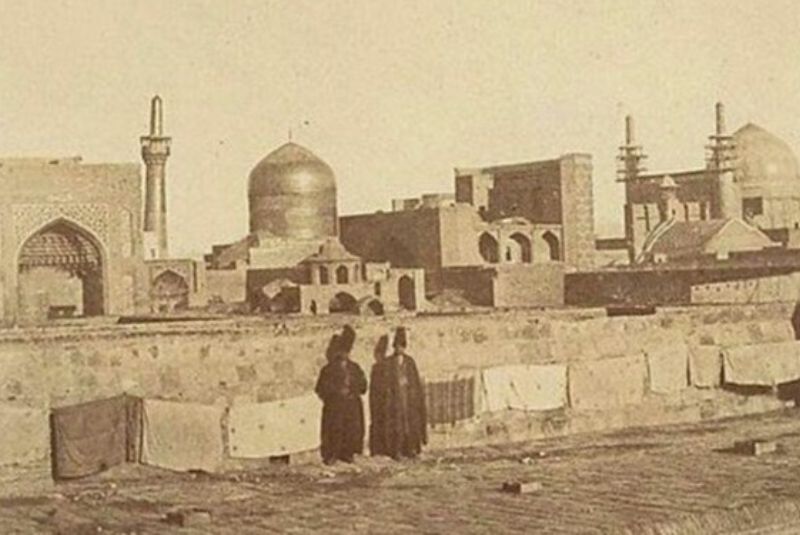
After the sacred body of the eighth Imam was buried in Sanabad, this area gained more significance and was named "Mashhad." Later, this village merged with surrounding villages, and with the displacement of Tus, present-day Mashhad came into existence.
With the presence of Imam Reza, Mashhad flourished. During the Samanid period, the first steps were taken to construct the shrine of Imam Reza in this location, which was later destroyed throughout history. During the Ghaznavid period, the structure was revived, and a new dome was built.
In subsequent periods, during the Seljuk and Khwarazmshah dynasties, changes were made to the structure, and repairs and reconstructions took place. However, after the Mongol invasion, the building suffered damage once again.
During the Safavid period, with the recognition of Shia Islam as the official religion, the shrine of Imam Reza was completely rebuilt and restored, expanding during subsequent reigns.
During the Afsharid period, the gilding of the courtyard continued, and during the Qajar period, a new sarcophagus was prepared for the shrine. Then, during the Pahlavi period, the Imam Reza Shrine underwent renovations and changed its usage.
After the Islamic Revolution in Iran, a development plan for the shrine of Imam Reza was implemented, resulting in significant changes; to the extent that the area of the shrine has now reached approximately one million square meters.
| Related: Imam Reza Bazaar in Mashhad - Shop for Authentic Souvenirs
Architecture of the Imam Reza Holy Complex
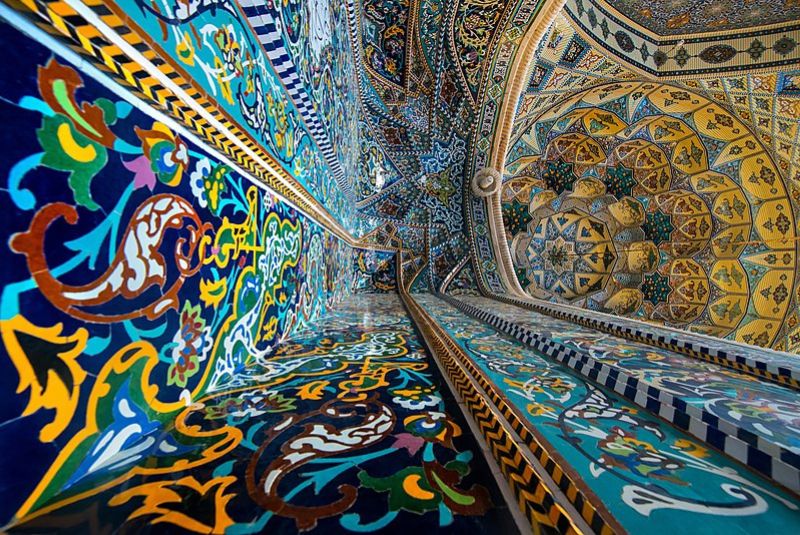
The Imam Reza shrine is considered one of the largest religious sites in the world and is renowned for its beautiful and unique architecture. The shrine's details and decorations have been meticulously designed to incorporate finesse and Islamic artistry that enhances its spiritual ambiance.
In fact, we can witness masterpieces of various arts, including plasterwork, tilework, marquetry, and mirrorwork, within this shrine. As mentioned in the history of the shrine's construction, its architecture has been completed over many years and has not been solely designed by a single individual.
The first stone of the eighth Imam's mausoleum, with the dates of his birth and martyrdom inscribed in Kufic script, was made of marble and is currently preserved in the shrine's museum.
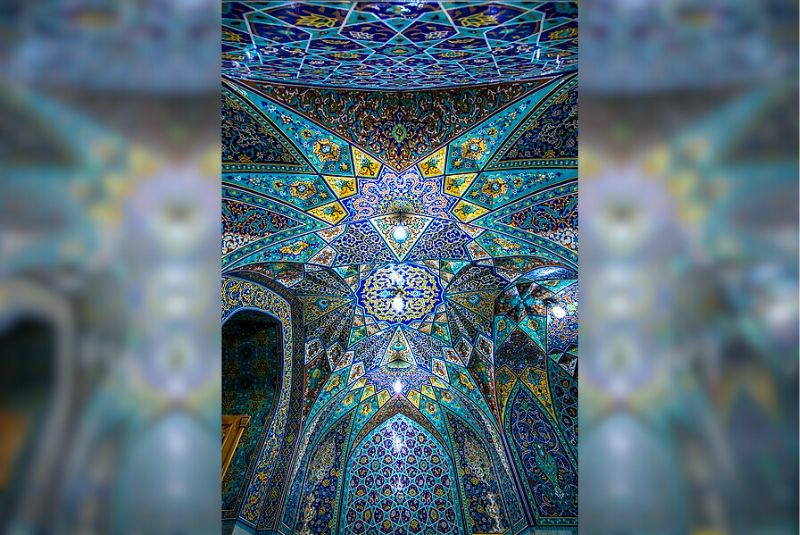
The Shrine of Imam Reza consists of ten courtyards, including the Rezavi Grand Courtyard, the Enghelab Courtyard, the Azadi Courtyard, the Kowsar Courtyard, the Rezvan Courtyard, the Goharshad Courtyard, the Quds Courtyard, the Ghadir Courtyard, and the Hedayat Courtyard.
In addition to the multiple courtyards, there are numerous beautiful vaulted spaces, each with its own unique beauty. The vaults in this shrine are twenty-four in number, with one of the largest being the Imam Khomeini Vault, which was previously a courtyard and is now covered and vaulted.

The Balasar Mosque is the oldest mosque in the shrine, located on the western side of the burial chamber, and it is where pilgrims enter after their visitation. The Goharshad Mosque is another famous mosque with exceptional architecture. Throughout this mosque, you will observe intricately designed tiles featuring the names of Allah and various Quranic verses. This beautiful mosque, with its blue-colored dome resembling the clear blue sky from a distance, incorporates an exquisite Thuluth calligraphy plaque, intricately carved, displaying the history of the mosque's construction.
There are also several iwans (vaulted halls) within the shrine, with the most famous one being the Golden Iwan, which features golden bricks and a golden roof. Minarets and domes are among the most striking features of any religious site, and the Shrine of Imam Reza has twelve minarets and domes, some of which are adorned with goldwork, representing the most beautiful and prominent architectural characteristics. Multiple water houses (saghakhanes) are present in the courtyards, enhancing the architectural allure of this magnificent complex.
| Read more: Top 14 Religious Tourist Attractions in Iran
Map of the Holy Shrine of Imam Reza

The shrine of Imam Reza is a destination for many lovers who visit this place for pilgrimage every year. This magnificent structure represents the pinnacle of Iranian-Islamic beauty and grandeur, comprised of porticos, courtyards, and various other sections.
After the 1979 Revolution, the Astan Quds Razavi underwent significant changes. Many of the courtyards you see in the shrine today were built as part of the post-revolutionary development plan, expanding the area of this religious structure from 12 hectares in previous periods to 100 hectares.
The presence of pilgrims from various cities and neighboring countries, who come to Mashhad for pilgrimage, has made this city always bustling and crowded. For this reason, familiarizing yourself with the different sections of the shrine will help you reach your destination more quickly and through easier and closer routes. Below, you can see an overview of the map of the Imam Reza Shrine.
| Discover: Ancient Village of Nashtifan near Mashhad
Recommended Time and Entrance Fee of Imam Reza Shrine
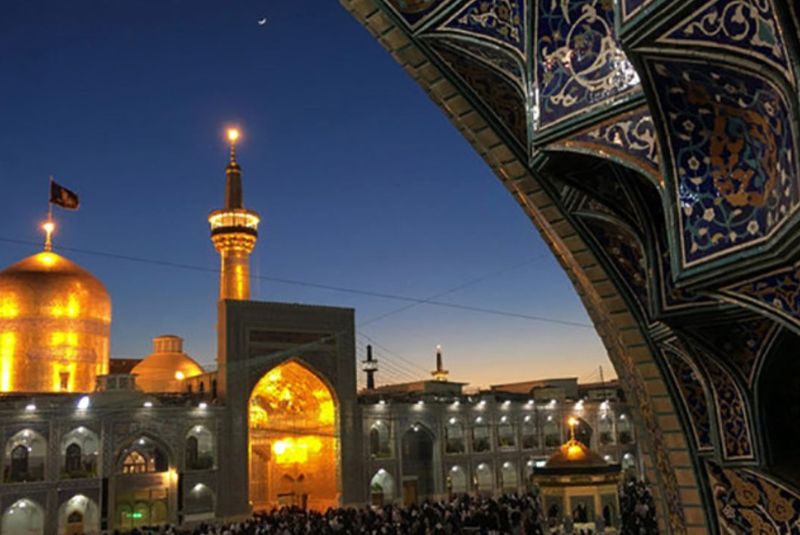
There is no fee to visit the Shrine of Imam Reza, and your expenses will only include accommodation and travel to Mashhad. The time required for visiting the shrine depends on your preferences, whether you intend to participate in congregational prayers or engage in any group worship activities. On average, you may need around 3 to 4 hours to visit the entire shrine and its various sections.
Best Time to Visit Imam Reza Shrine
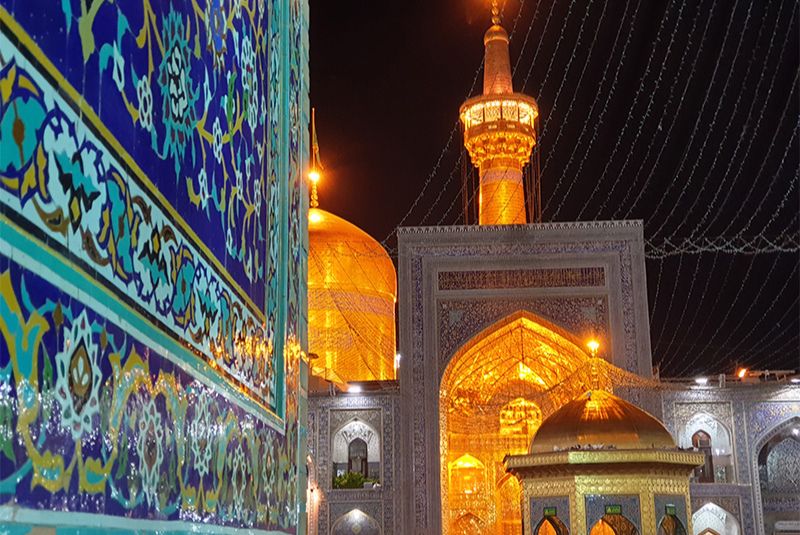
The Shrine of Imam Reza holds a special allure throughout all seasons and times of the year. However, purchasing train tickets to Mashhad during religious holidays and the Persian New Year (Nowruz) can be challenging due to the high demand. The winter season is relatively less crowded, providing a more tranquil and peaceful environment for visitation.
| Also read about: Best Hotels in Mashhad
Imam Reza Shrine Location
The Imam Reza Shrine is situated in the Khorasan Razavi Province, in the city of Mashhad, Iran. Its address is Ayatollah Khazali 4, near Sarab Bazaar.
Access to the Shrine of Imam Reza
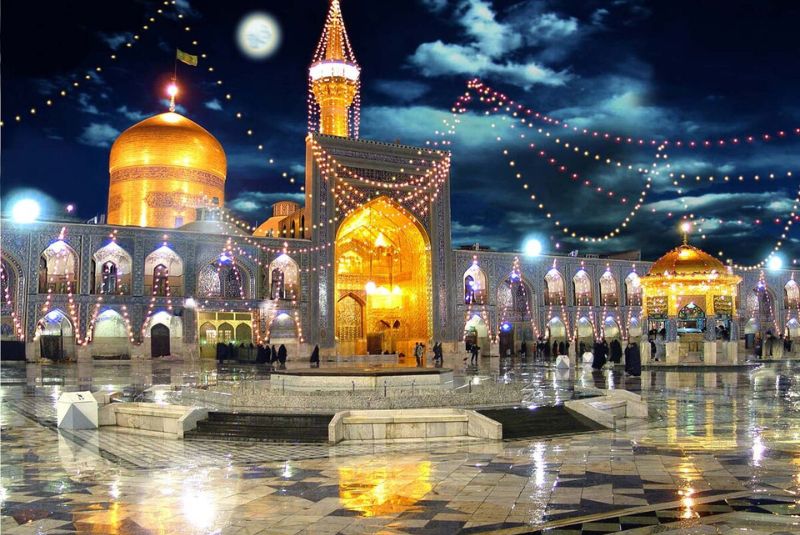
To reach the sacred shrine, there are various ways available, which we will explore below.
Private Vehicle
The routes leading to the Shrine of Imam Reza are usually congested, and you may have to spend a considerable amount of time reaching the shrine. However, if you prefer to go to the holy shrine with your private vehicle, there are several parking lots within the shrine complex where you can park your car.
If you are coming from the west, proceed from the route leading to Shohada Square to Shirazi Street and enter the shrine's underground passage to reach the shrine's parking lot. To access the shrine from the east, enter the shrine's underground passage from Navvab Street. If you are approaching from the southern part, enter Imam Reza Boulevard and Beit al-Maqdis Square, then proceed to the shrine's underground passage.
Metro
Many travelers prefer to use the metro to avoid traffic congestion. To reach the shrine by metro, you can walk from Shohada (East), Hezar Dastgah-e Shahrivar, and Shahid Mofateh (West), or Basij (South) stations and make your way to the shrine.
Bus
Buses can be found at various points throughout the city and offer a much lower cost compared to taxis, Snapp (ride-hailing service), and other options. From wherever you are, board the buses heading toward the shrine and disembark at nearby stations such as Basij, then proceed on foot to the shrine.
| Suggestion: Best Restaurants in Mashhad - The Top 7
Facts about the Imam Reza Shrine
In addition to being a place for tranquility and closeness to the Almighty, this religious and spiritual site holds interesting stories and secrets. Here are some fascinating facts:
- The shrine of Imam Reza houses a collection of handwritten, printed, and lithographic books, some of which date back 12 centuries.
- The holy sarcophagus of Imam Reza weighs 12 tons and is made of gold and silver.
- Around 28,000 lamps and 6,000 chandeliers of various ages are installed in this place, creating a spectacular sight during the night.
- There are 14 openings surrounding the sarcophagus of Imam Reza, symbolizing the 14 infallibles.
- Every year, 700,000 seals are replaced to replace damaged and broken seals on the shrine of Imam Reza.
- The historical antiquity of the building, traditional architecture, and the presence of valuable objects have led to this place being recognized as a religious museum.
- On this religious site, there are also tombs of other individuals such as Pir Palanduz, Har Ameli, Sheikh Bahai, and Sheikh Tusi.
Bottom Line
The Imam Reza holy complex in Mashhad, Iran, is a place of profound spiritual significance and architectural splendor. This sacred complex welcomes millions of pilgrims and visitors every year.
Visiting Imam Reza shrine offers a transformative experience, where one can witness the fusion of faith, history, and artistic craftsmanship. The complex encompasses a vast complex of buildings and courtyards. The complex also accommodates various facilities, including mosques, museums, libraries, and bazaars.
It also showcases stunning architectural marvels, intricate tile work, and breathtaking calligraphy. Pilgrims and visitors can immerse themselves in the spiritual ambiance.
Share your story!
Comment below and let us know about your Experience.
Your story inspires others!


Comment
Leave a Comment